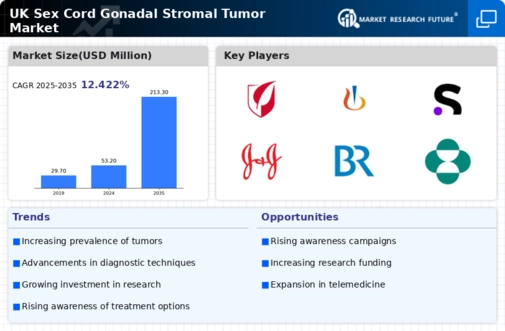Rising Incidence of Tumors
The increasing incidence of sex cord-gonadal-stromal tumors in the UK is a notable driver for the market. Recent statistics indicate that these tumors, although rare, are being diagnosed more frequently, particularly among women. This rise may be attributed to improved awareness and advancements in diagnostic techniques. As healthcare professionals become more adept at identifying these tumors, the sex cord-gonadal-stromal-tumor market is likely to experience growth. The National Health Service (NHS) has reported a steady increase in referrals for suspected cases, which could lead to a higher demand for specialized treatments and therapies. Consequently, this trend may stimulate investment in research and development, further enhancing the market landscape.
Growing Awareness and Education
Growing awareness and education regarding sex cord-gonadal-stromal tumors are pivotal drivers for the market. Increased public and professional knowledge about these tumors can lead to earlier diagnosis and treatment, which is crucial for improving patient outcomes. Educational campaigns by health organizations in the UK aim to inform both healthcare providers and the general public about the signs and symptoms of these tumors. This heightened awareness may result in more patients seeking medical advice, thereby increasing the demand for diagnostic services and treatment options. The sex cord-gonadal-stromal-tumor market stands to gain from this trend, as more individuals become informed about their health and the importance of early detection.
Supportive Regulatory Environment
A supportive regulatory environment in the UK is fostering growth in the sex cord-gonadal-stromal-tumor market. Regulatory bodies are increasingly streamlining the approval processes for new treatments and diagnostic tools, which can expedite the availability of innovative solutions to patients. This environment encourages pharmaceutical companies and researchers to invest in the development of new therapies. The UK Medicines and Healthcare products Regulatory Agency (MHRA) has been proactive in facilitating clinical trials and ensuring that effective treatments reach the market swiftly. As a result, the sex cord-gonadal-stromal-tumor market is likely to see an influx of new products, enhancing treatment options for patients and potentially improving survival rates.
Innovations in Treatment Modalities
Innovations in treatment modalities for sex cord-gonadal-stromal tumors are significantly influencing the market. The introduction of novel therapies, including hormonal treatments and surgical interventions, has expanded the options available for patients. Recent clinical trials have shown promising results, indicating that these new approaches may improve patient outcomes. The sex cord-gonadal-stromal-tumor market is likely to benefit from these advancements, as healthcare providers seek to offer the most effective treatments. Furthermore, the UK government has been supportive of initiatives aimed at fostering innovation in cancer care, which may lead to increased funding for research and development in this area. As a result, the market could see a surge in new product launches and treatment options.
Increased Collaboration Among Stakeholders
Increased collaboration among stakeholders in the healthcare sector is emerging as a key driver for the sex cord-gonadal-stromal-tumor market. Partnerships between academic institutions, healthcare providers, and pharmaceutical companies are fostering research and development efforts. Collaborative initiatives can lead to shared resources, knowledge, and expertise, which are essential for advancing treatment options. The UK has seen a rise in multi-disciplinary teams working together to address the complexities of sex cord-gonadal-stromal tumors. This collaborative approach may enhance the understanding of these tumors and lead to the development of more effective therapies. Consequently, the sex cord-gonadal-stromal-tumor market is likely to benefit from these synergies, resulting in improved patient care and outcomes.






















Leave a Comment